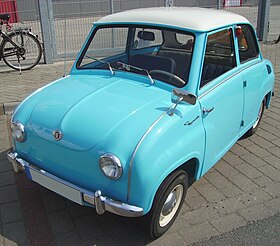| Goggomobil | |
|---|---|
 | |
| Overview | |
| Manufacturer | Hans Glas GmbH (1955–1966) BMW (1966–1969)[1] |
| Production | 1955–30 June 1969[2] |
| Body and chassis | |
| Class | Microcar |
| Layout | RR layout |
| Body style(s) | 2-door sedan[2] 2-door coupe[3] 2-door convertible[4] Van[5] Pickup[6] Roadster (Goggomobil Dart)[7] |
| Vehicles | Goggomobil T (2-door sedan)[2] Goggomobil TS (2-door coupe)[3] Goggomobil TL (van)[5] Goggomobil Dart (roadster)[7] |
| Powertrain | |
| Engine(s) | Two-stroke straight-twin engine 245 cc, 13.6 hp (10.1 kW) (DIN) 293 cc, 14.8 hp (11 kW) (DIN) 392 cc, 18.5 hp (13.8 kW) (DIN)[2][3][5] |
| Transmission(s) | 4-speed manual electromagnetic pre-selector transmission optional[2][3][5] |
| Dimensions | |
| Wheelbase | 1,800 mm (70.9 in)[2][3][5] |
| Length | 2-door sedan: 2,900 mm (114.2 in)[2] 2-door coupe: 3,035 mm (119.5 in)[3] Van: 2,910 mm (114.6 in)[5] |
| Width | 2-door sedan: 1,260 mm (49.6 in)[2] 2-door coupe: 1,370 mm (53.9 in)[3] Van: 1,316 mm (51.8 in)[5] |
| Height | 2-door sedan: 1,310 mm (51.6 in)[2] 2-door coupe: 1,235 mm (48.6 in)[3] Van: 1,695 mm (66.7 in)[5] |
Goggomobil was a series of microcars produced by Hans Glas in the Bavarian town of Dingolfing between 1955 and 1969.
Glas produced three models on the Goggomobil platform: the Goggomobil T sedan, the Goggomobil TS coupe, and the Goggomobil TL van. The engine was an air-cooled, two-stroke, two-cylinder unit originally displacing 250 cc, but later available in increased sizes of 300 cc and 400 cc. It had an electric pre-selective transmission built by Getrag and a manual clutch. The engine was behind the rear wheels. Suspension was independent all round using coil springs with swing axles.
214,313 sedans, 66,511 coupés, and 3,667 Transporter vans and pickups were built from 1955 to 1969.
- ^ Norbye, Jan P. (1984). "Expanding on Excellence: The 5-Series and 3-Series". BMW - Bavaria's Driving Machines. Skokie, IL, USA: Publications International. p. 192. ISBN 0-517-42464-9.
- ^ a b c d e f g h i "GLAS Automobil Club International e.V. - Vehicles - Goggomobil Sedan". 2011-07-26. Archived from the original on July 26, 2011. Retrieved 2012-10-12.
- ^ a b c d e f g h "GLAS Automobil Club International e.V. - Vehicles - Goggomobil Coupé". 2011-07-26. Archived from the original on July 26, 2011. Retrieved 2012-10-12.
- ^ UK Sales brochure for Goggomobil Regent & Mayfair models Retrieved from www.webcitation.org on 19 January 2012
- ^ a b c d e f g h "GLAS Automobil Club International e.V. - Vehicles - Goggomobil Van". 2011-07-26. Archived from the original on July 26, 2011. Retrieved 2012-10-12.
- ^ The Goggomobil Van, GLAS Automobil Club International e.V. Retrieved on 18 January 2012
- ^ a b "The Bruce Weiner Motorcar Museum - 1958 Goggomobil Dart". Microcarmuseum.com. Retrieved 2012-05-06.